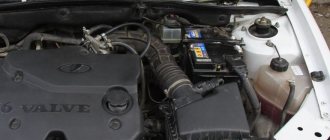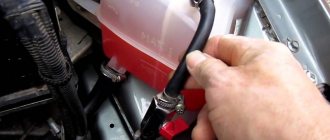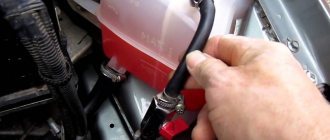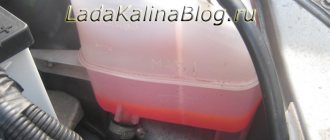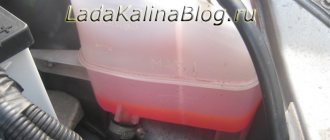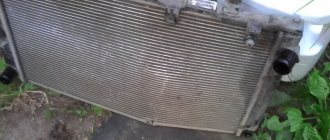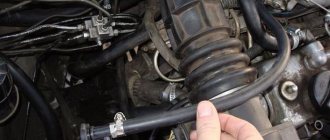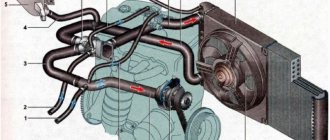The weak point in many cars is the airing of the cooling system and the occurrence of traffic jams; Lada Kalina was no exception. A design flaw requires modernization and modification of the system, especially since this can be done with your own hands.
Coolant or antifreeze passes through the large and small circles, first it has to heat up to the desired temperature, and then pass through the radiator. The correct operation of the engine and furnace mechanism depends on how correctly the cooling system functions.
Dependence of the appearance of an air lock in the cooling system on the expansion tank cap
When the liquid in the cooling system is heated, it expands and pressure in the system increases.
In order to prevent the system from rupturing, the cap of the expansion tank must release excess air when the pressure rises to 1.3 atmospheres. When cooling, the liquid and air compress and a vacuum appears in the system. To prevent air from being sucked in from under the pipes, the cover must freely allow air into the expansion tank. Often these covers are of poor quality or simply oxidize and stop normally letting air in and out from outside, which causes air to be sucked in at weak points and, accordingly, the system is re-aired. It also happens that the cover valves freeze when the engine cools down.
To troubleshoot the lid, try sucking air out of it from the back side; if air does not flow in or it comes in with obvious force, then it’s time to change the cover. The presence of freezing is checked in the following way: leave the heated car until it cools completely, then unscrew the lid and look at the valves; if they are completely covered in ice, then the problem is condensation. In case of freezing, you can try treating the lid with silicone grease or VD-shkoy.
The last cover I took and it was the most successful:
Here's the other side:
There is also another option for dealing with bad caps - unscrewing them in winter to allow free air access in both directions through the threads. But keep in mind that in this case the maximum boiling point of the coolant will decrease.
How to expel air, with method No. 3
- With the engine cooled down, remove the upper hose from the expansion tank coming from the radiator of the cooling system.
- Fill the reservoir to the maximum with coolant and tighten the cap.
- We place the hose in an empty canister, and put a hose from the air pump (for inflating tires) on the tank nozzle.
- We pump up the pressure in the tank with a pump, and at the same time the antifreeze will pour into the canister.
- We monitor the level of coolant in the expansion tank and add it if necessary.
- After 2-3 additions of liquid, we restore all connections.
Airing the cooling system of the Lada Kalina
Excessive pressure in the cooling system
Airing the cooling system of the Lada Kalina is a common problem with this car. This phenomenon occurs under the influence of negative factors, in particular, malfunctions in the functioning of the machine. As a result, the cooling system begins to work incorrectly.
Car cooling system
Why does aeration occur?
Water and air are two interconnected elements. When a car malfunctions, they cause a “storm of emotions” in the cooling system. Usually the conflict occurs in a car radiator, which entails a lot of trouble. The first thing motorists notice is that the car is boiling. This happens while driving, and the temperature outside and the speed of movement do not always affect this process. Engine overheating is associated with malfunctions of the cooling system. This problem requires an immediate solution.
Most modern cars have liquid cooled engines. The radiator in them is the most necessary and mandatory part. Often, a car has two elements installed at once, one is the cooling system, the second is the heating or stove. For the engine to overheat, the development of one problem out of 3 existing ones is enough. The most common reasons why the system will bleed:
- thermostat jamming;
- lack of coolant;
- airing of the radiator.
It’s easy to check the functionality of the radiator: if the stove on Kalina produces hot air, but the main element is cold, it is necessary to replace the thermostat.
If there is a lack of coolant, the situation becomes more complicated. This problem can be identified by a warm engine. It is necessary to open the radiator cap and check the antifreeze level. If it is small, there is a high probability of leakage, resulting in airing of the system. It is possible that antifreeze is displacing exhaust gases. This is due to poor fluid circulation.
The last reason for the development of the problem is an air lock formed due to sucked air. This is due to the lack of sufficient tightness in the highways. Detecting a leak or finding a place of filtration is not difficult. It is more difficult to detect air leaks in the stove itself.
Another possible cause of airing is a violation of the integrity of any element. This may cause the tray to close, causing it to work backwards. You can identify the reason why the system is airing yourself.
Solving the air problem
Experts identify 3 main ways to solve the current situation.
Option 1. It is necessary to remove the hose from the heating and open the cap on the expansion tank. Then cover it with a rag (it must be clean) and blow. When antifreeze begins to come out from the removed tube, the hose must be quickly inserted back and tightened with a clamp. It should be said that coolant is poisonous and should not be swallowed under any circumstances. After the manipulation, the air lock disappears.
Option 2. In this case, it is necessary to warm up the engine - this will increase the pressure. Then the viburnum engine is turned off and the hose is removed according to the first option. There is no need to touch the tank lid; it is in the closed position. When antifreeze runs out of the hose, you need to quickly put it back on and tighten it
Caution should be exercised during operation as the antifreeze may be hot.
Option 3. How to remove air in this case? After the engine has cooled, it is necessary to remove the hose from the reservoir that goes to the cooling system. Then it is filled with coolant and the plug is tightened. The hose must be placed in an empty canister, and the tube from the air pump must be put on the nozzle. This way the pressure is pumped up; during this process you need to monitor the liquid level. If necessary, it must be topped up, but no more than 2-3 times.
How to expel air if the situation constantly repeats itself? You can use any of the described methods, but it is recommended to check all system connections for leaks. Thus, Kalina will never become airy.
How to improve SOD?
At the moment, there are several ways to improve ODS:
- Reworking the cooling system. “Kalina” in this case is equipped with a new 6-hole thermostat. This action will make maintaining the temperature of the antifreeze in the system more stable, and will also normalize the operation of the heating elements of the cabin.
- To reduce cooling system malfunctions, the Lada Kalina is equipped with a coolant filter.
- Installation of the stove faucet.
- Additional pump in the engine cooling system. It will not only prevent you from freezing in your car during winter cold, but will also force antifreeze to circulate faster through the channels, which will significantly reduce the risk of engine overheating.
So, we found out how the cooling system in the VAZ Kalina is designed, what problems can arise with it, and how to fix these problems.
On a fully heated engine above 95°C, liquid does not circulate in a large circle. I bled the pipes manually, everything seemed to be fine, I drove on. After 5 kilometers the temperature rose again, I stopped, opened the hood, the radiator was cold, the fans were spinning and it always did.
- Lada Kalina heater radiator is leaking - 3 answers
- Air the stove in the Lada Kalina - 3 answers
- VAZ Kalina engine heats up at high speeds - 3 answers
- The temperature has risen to 110, and the heater is blowing cold air - 3 answers
- Air gets into the cooling system, VAZ Kalina - 3 answers
The pump pumps a trickle into the expansion tank, not necessarily passing through the radiator - this can be said to dump the excess, and from the bottom of the tank it again goes into the cooling system. After all your stories, I have the opinion that the coolant does not circulate through the entire radiator, that is, at most it circulates only through the radiator tank on which the pipes are attached, and then it seems very weak.
Judging by the active stream into the expansion tank, coolant is being pumped into the upper pipe; all that remains is to check whether it reaches the lower one. With a warm engine running, the top pipe should also be warm, and the bottom pipe should be cold.
We wait further until approximately 90 degrees - the top one is already hot, and the bottom one should also be hot, if it is cold, then the thermostat has not opened, if it is hot, and the radiator tank on the other side and the entire radiator is cold, then the coolant is not circulating through the radiator. Remove the radiator, open it, clean it (but this is labor-intensive work, not all specialists even undertake this; it’s easier to buy a new one).
As for flattening, the thermostat has opened, the pump is working, the fluid is circulating, and since there is no circulation through the radiator, it seems to suck the fluid from the pipes, driving it in a small circle and through the expansion tank. The performance of the pump is decent.
Airing of the Lada Kalina cooling system is a common problem with this car. This phenomenon occurs under the influence of negative factors, in particular, malfunctions in the functioning of the machine. As a result, the cooling system begins to work incorrectly.
What to do before removing the plug.
GAZ 31 029 Black Logbook About the cooling system
First of all, you need to understand why an air lock forms, for this:
- We check for coolant leaks in the connections of the pipes, if there are any, we tighten the clamps or replace them.
- We check the coolant level in the expansion tank; for viburnums, it is advisable to keep the level at or slightly above the maximum.
- We check the correct operation of the expansion tank plug; if the air inlet plug does not work or with noticeable difficulty, then it is better to replace it; below I will explain in more detail about the plug.
- It is also advisable to check whether the interior heater radiator is leaking; this can be done from inside the cabin by removing the right lower side of the panel under your feet and feeling the floors and the heater block itself.
How to bleed air using the VAZ model range as an example
VAZ models have a design advantage in the arrangement of cooling system components - a convenient position of the cooled throttle assembly (carburetor), which is the highest place in the cooling system. The procedure for a Lada Kalina car is as follows (the only tool you need is a Phillips screwdriver).
Fully open the heater switch (to the highest temperature);
Remove the valve cover protective screen;
Disconnected heating outlet hose from the throttle fitting
Remove the cap from the expansion tank
Video: How to remove air from the expansion tank
The second method of releasing air differs from the first only in that you do not need to force air masses into the neck of the expansion tank with your mouth. All operations are performed with the engine normally warmed up and turned off. This method does not involve any manipulations with the expansion tank cap. Immediately remove one of the two heating hoses from the throttle fittings. If coolant leaks, the hose is inserted into place and tightened. It may not work out the first time, then the operation must be done again. This method requires care and caution, since the antifreeze is heated to a temperature of 90 degrees and is under increased pressure.
The third method does not require any disassembly of the cooling system. True, its effectiveness is not very high. The car drives its front wheels onto an embankment so that the radiator cap becomes the highest point in the cooling system. The radiator and expansion tank caps are removed. The engine starts, the antifreeze temperature is brought to operating parameters. When reducing the volume of coolant, it must be constantly added to the amount recommended by the manufacturer. It is necessary to expel the air lock until bubbles stop coming out of the neck of the radiator or expansion tank.
Air lock in the cooling system of Lada Kalina signs, repair
The water in the cooling system is frozen, what to do?
Any car model is, first of all, a complex type of equipment, which consists of numerous components and assemblies. Unfortunately, sooner or later one of the elements may fail, since during operation of the machine various components inevitably heat up, according to the laws of physics. To prevent severe overheating, the Lada Kalina, and all other cars, is equipped with a cooling system in which air can form.
If the air lock in the cooling system of the Lada Kalina is not removed in a timely manner, then such a malfunction can damage various components and even lead to engine failure. Therefore, car owners definitely need to get their car repaired at the first sign of a breakdown. Facebook blog of Igor Spodin about sports. We will analyze further where the air in the cooling system can come from and how to remove it according to the rules.
The main signs of an air lock
Lada Kalina car owners will be able to independently understand that an air lock has formed in the cooling system based on the following signs:
- The heating system of the car will not work well or will refuse to function at all. This type of malfunction occurs due to the fact that the air lock that appears does not allow antifreeze or other coolant to penetrate into the radiator.
- The car will begin to overheat greatly, which will be indicated by a special indicator located on the dashboard. And the overheating of the car is explained by the same air lock, which prevents the free movement of coolant through a special cooling system.
- There are other signs that indicate the occurrence of an air lock, so before fixing the problem, experts recommend checking the condition of all components that are included in the cooling system.
Once the cause of the defect has been determined, air should be removed from the cooling system as quickly as possible.
Even a car owner without experience can cope with such a task if he strictly follows the recommendations and instructions from real professionals in their field.
Step by step fix
Quite often, car owners notice that after the car warms up, air “leaves” from the cooling system without any action. And this may indeed be the case, but only if the thermostat, into which the coolant flows from the engine, is fully functioning. Therefore, first of all, you should check the operation of this element and, if necessary, replace it. And after replacing the thermostat, it is imperative to drain all the coolant and replace it with new one.
If the thermostat does not require replacement, it’s time to begin gradually removing air from the cooling system, having prepared in advance for this task keys of the appropriate size, with which you can remove the clamps and protection, as well as a regular screwdriver for working with fasteners:
- the plastic protection of the case is removed from the fixing pins;
- remove the clamp from the upper or lower pipe;
- unscrew the cap from the expansion tank, and cover the neck with a clean rag;
- then you just need to supply air through a rag into the expansion tank, blowing into its neck with all your might;
- if the above steps are performed correctly, a little coolant will spill out of the pipe;
- the pipe is put back in its original place and secured with a clamp;
- the housing protection is installed in its original place.
As you can see, it is quite easy to remove air from the cooling system of the Lada Kalina yourself, and watching a training video on an online resource will help to further simplify this process and get answers to any questions related to the topic being analyzed.
VAZ cars: repair, maintenance, tuning
A sealed cooling system ensures that the heater will work properly and the engine will not overheat, since the antifreeze circulates stably. However, as soon as an air lock appears, the efficiency of the cooling and heating system comes to an end. We’ll figure out how to remove an air lock from the cooling system of the Lada Kalina right now.
Possible malfunctions of the ODS, diagnostics
Almost always, a breakdown of the cooling function of a car is caused by an antifreeze leak. You should inspect the car under the hood for possible leaks. The cause of the leak may be:
- or a leaky clamp;
- or a radiator failure.
Then in the first case the element is replaced; this is not difficult and does not take long. As for the radiator, it is better to have it repaired. There are also no particular difficulties here: often you just need to solder the holes.
The reasons for overheating of this car can also be:
- thermostat. Its suitability is checked using both pipes: the temperature of the latter should not be sharply different (this is determined on a warm engine). Otherwise, the thermostat is faulty and antifreeze circulates in a small circle;
- clogging of radiator honeycombs. You can solve the problem by cleaning the outside of this element. Often this is not always easy to do, but there are no other methods other than manually cleaning the honeycombs;
- Fan malfunction. When the heating level of the coolant increases, this part should begin to operate. If this does not happen, check the relay, wiring or t° sensor;
- air in the coolant system. Lada Kalina is not insured, among other things, against the so-called air lock inside the system. In general, previous types of breakdowns are eliminated quite quickly and almost everything is clear with them. In the latter case, it is necessary to understand in more detail. The question - how to remove air from the Kalina cooling system - is really very important for the optimal functioning of the totality of the elements of this car.
Airlock
If the cooling system becomes airy, you need to do the following: with the expansion tank cap open, start the power unit, squeezing the gas pedal from time to time, warm it up until the t° sensor “reaches” the red scale. After “starting” the ventilation device, “add up the gas” a little more and then you can turn off the ignition.
If the cooling system is still leaking air and the above measures have not led to anything, you should act more radically. What needs to be done to remove air from the cooling system?
First, remove the power motor screen (dismantling is done in an upward direction).
Loosen the clamp with a screwdriver and remove one of the tubes from the heating fitting of the throttle assembly.
Unscrew the cap of the expansion tank. Cover the neck of the opened container with a clean piece of cloth. Now blow into the tank: coolant should flow from the tube that was removed. If you fail to break through the above container, close the lid and place the tube in its place.
Next, warm up the engine again and turn off the ignition. Then the tube must be removed again, without removing the lid from the tank, and wait until the antifreeze flows.
Since this liquid is very poisonous and dangerous for people, drain the coolant with extreme caution. Remember about safety: get rubber gloves
Monitor the temperature of the tubes. Keep in mind that you only need to drain the coolant when the engine has cooled down.
Now the tube is put on the fitting, the clamps are tightened. At this stage, the problem of how to remove air from the cooling system of the car has been successfully solved. As you can see, it is possible to eliminate faults in the ODS without the participation of professionals.
SOD Lada Kalina in a certain sense requires improvement.
At the moment, there are the following methods to improve it:
- rework. The car is equipped with a new thermostat. Thus, the temperature of the antifreeze will become stable, and the activity of the interior heating elements will return to normal;
- to minimize coolant malfunction, the machine is equipped with a coolant filter;
- an additional pump in the above-mentioned power unit system. This will force the antifreeze to circulate through the appropriate channels faster, which will definitely reduce engine overheating. And a plus - in cold weather you will not freeze in the car.
Everything that may be important for a motorist on the above topics regarding the Kalina car: what the Lada Kalina heating system is, as well as airing the cooling system, why the cooling system will air, how to remove air from the cooling system, possible malfunctions, necessary alterations more clearly will tell the presented video.
Let's sum it up
If the owner of a Lada Kalina with an 8 or 16 valve engine does not have the confidence to independently correct the defects that have arisen in the cooling system, then the only effective action will be to contact a disinterested professional; a cooling scheme can also help. He will quickly diagnose the system, identify the cause and promptly eliminate it. Independent experiments are undesirable, since ignorance coupled with the desire to eliminate the malfunction can only add damage to the long-suffering cooling system.
Functional range of elements of a car cooling system
The standard cooling system consists of the following elements:
- sensors – determine t° in certain auto mechanisms; one of the management elements of the system;
- pump – makes it possible to circulate liquid in the SOD; operates in a forced mode;
- pipes – coolant moves through them;
- expansion tank - compensates for the volume of antifreeze, since due to temperature fluctuations it narrows and expands;
- radiator - a device that discharges excess heat into the environment;
- fan – activates the cooling process by forcing air; With its help, the cooling intensity increases;
- Thermostat - although small, is a very important element that regulates the amount of antifreeze; provides a “comfortable” temperature regime throughout the entire system.
Operating principle
The cooling system operates in a self-regulating mode, which is aimed at maintaining optimal temperature in the power unit. If the oil temperature rises significantly, the system does everything to ensure that the temperature inside the engine decreases.
Thus, with the close interaction of the above elements, the system functions. It automatically sets the necessary conditions for the inclusion and operation of structural parts, which ensures effective cooling of the power unit.
And if any problems arise with the functionality of the components of this system, it is necessary to carefully examine the safety of its main components. If the driver is qualified and experienced enough, he can cope with the task independently. Otherwise, it is better for an owner who is not very knowledgeable about cars to seek help from a service station.
Design elements
The expansion tank of the Lada Kalina car is made of transparent polyethylene. The system in question is sealed due to the presence of inlet and outlet valves. The SOD scheme in Kalina provides for the presence of a coolant pump. The device body is made of aluminum. There is a control hole inside the unit, which can be used to detect fluid leakage if the pump breaks down.
The engine cooling system of the Lada Kalina car consists of 2 circulation circles:
- the liquid moves through the jacket and radiator (large circle);
- the liquid moves only along the jacket (small circle).
The SOD scheme provides for constant circulation of liquid. This does not take into account the position of the thermostat valves. The last device consists of 2 valves that redistribute the flow of coolant. When the engine is cold, the fluid circulates in a small circle.
Air has entered the engine cooling system; these are the main signs of airing.
For a better understanding, let's start with the general operating principles. While the engine is cold, the liquid circulates only through the cooling jacket (special channels in the cylinder block and cylinder head), without entering the radiator. Circulation is provided by a water pump.
After the coolant temperature reaches a certain value, the thermostat is activated, which opens a large circle (the liquid passes through the radiator). If cooling the coolant when driving in a large circle is not enough, then the engine cooling fan (air cooling) is automatically switched on.
At the same time, it is important that the system works correctly, since its effectiveness depends on maintaining the optimal temperature of the internal combustion engine, the normal functioning of the interior heater (stove), etc.
Please note that these malfunctions can occur for various reasons, that is, the engine begins to overheat not only due to air locks, but this possibility should also not be excluded. As with any closed fluid system, air pockets can cause the system to stop operating normally.
In this case, the risk of engine overheating also increases significantly, and the stove stops working normally.
As with any closed fluid system, air pockets can cause the system to stop operating normally. In this case, the risk of engine overheating also increases significantly, and the stove stops working normally.
- The main sign of air lock formation is engine overheating. In other words, the temperature rises above normal, the temperature gauge may rise to the red zone. In this case, when checking the coolant level in the expansion tank, no deviations may be detected.
- Also, during the cold season, the driver may notice that practically no warm air enters the cabin, although the engine is normally warmed up. This also indicates that there may be air in the cooling system.
One way or another, the air lock does not allow coolant to circulate normally through the channels of the cooling system. As a result of impaired circulation, certain problems arise. As part of diagnosing the engine cooling system, you should check the coolant level in the expansion tank, and also carefully inspect individual areas of the system.
Leaks of antifreeze or antifreeze, or any visible damage to hoses and pipes are not allowed. You also need to check the reliability of fixation of the clamps at the joints. It often happens that air gets into the system precisely because the clamp is not tightened or has become unusable.
We also note that air can enter through subtle cracks in the rubber pipes, but there may not be intense leaks through these cracks. Usually such cracks are not immediately visible, but a detailed inspection or injection of air into the system under pressure for testing can reveal problem areas
Also during the check you should pay attention to the pump, check the operation of the thermostat and cooling fan
If everything is normal, then there is a high probability that the stove is not working and the motor is overheating precisely because of air locks. In this case, it is necessary to take measures and “drive” such a plug from the cooling system.
Refinement of SOD from airing
Owners of LADA Kalina (1.6l, 8kl) cars are offering a simple modification that will solve the problem of constant airing of the engine cooling system. If the antifreeze leaves, then you should look for a leak. If the antifreeze stands still and an air lock appears periodically, you should extend the hose from the radiator so that its end is immersed in the coolant in the expansion tank:
If this modification does not help and airing of the cooling system occurs periodically, then the car’s cooling system is not sealed. Check the connections of all system hoses for leaks, as well as the expansion tank cap.
Source
